Transient Woodpecker: a short history of the object "Chernobyl-2"

Since the summer of 1976, shortwave communications around the world began to be terrorized by the “ether hooligan”. At a number of frequencies allocated to civilian communications and aviation, a characteristic knocking signal with a frequency of 10 pulses per second settled, interfering with negotiations and broadcasts in many countries. This knock brought to white heat both radio amateurs and those for whom radio communication was a professional tool. Judge for yourself:
https://ru.wikipedia.org/wiki/%D0%A4%D0%B0%D0%B9%D0%BB:Woodpecker.ogg
Moreover, the signal was "floating" - after working for several minutes at one frequency, he switched to another. Mysteriousness and inconvenience caused the military of a number of countries to try to divert the source. It turned out that it is located in the depths of the Soviet Union. And since the signal, which by that time received the nickname “Russian Woodpecker,” periodically invaded the frequencies reserved for aviation, the United States, Great Britain and Canada were not slow in using this, having declared a protest to the USSR. The USSR made a surprised face and replied that it knew nothing about any signal.
Time passed, and the situation did not change - despite the results of direction finding, the Soviet Union refused to recognize the source of the signal. It got to the point that radio amateurs tried to drown it on their own, transmitting a similar signal in antiphase. But it turned out that the Woodpecker was hammering with an unimaginable force - the signal was of such power that all attempts at jamming looked like attempts to stop the sea wave with a jet of hose.
')
The Western press and politicians have put forward various assumptions about Dyatl — that it is the Russian’s secret weapon for controlling the weather or for influencing the public’s mind. It seems to sound crazy, but the funny thing is that in the first approximation from a scientific point of view, it could well be true. In a number of countries, experiments have already been conducted with the effect of powerful electromagnetic radiation on brain work and human behavior. There are still legends about the possible influence of Nikola Tesla's high-energy experiments on atmospheric processes. So the idea that the most powerful short-wave radiation from the “iron curtain” could be a psycho-weather weapon, was quickly picked up and analyzed in the most serious military and scientific organizations.
In 1986, the signal disappeared from the air. Most likely, foreign intelligence services with the help of satellite intelligence even earlier managed to find out its origin, but this information is hidden in their archives. On all the Soviet maps of those years in the place where the source was located approximately, an inactive summer camp was indicated.

And only with the collapse of the Soviet Union, the general public found out why the USSR did not admit to the existence of the “Russian Woodpecker”. To say that “yes, we’re disturbing you a little bit, sorry” was absolutely impossible: the source of the signal was Duga, a completely secret over-the-horizon radar station located in Ukrainian forests - the Chernobyl-2 and Lyuchech-1 facilities complex . According to different information, the station worked in the range of 5-28 MHz. She was a member of the early warning system for a rocket attack, and through the North Pole “translucent” part of the territory of the United States.
What for?
Why do we need a network of powerful radar stations that can look at the other side of the planet? Let's briefly recall previous historical events.
After August 6 and 9, 1945, over our country, which had just won the war, which cost us more than 26 million people, a new threat arose with which we could not oppose anything. Disagreements between the former allies in the anti-Hitler coalition turned into a cold war and an arms race. The USA, which did not know mass destruction and received a powerful economic impetus due to the war, had a big head start in the development and production of not only atomic weapons, but also their delivery vehicles - long-range bombers. Stalin was well aware of the vulnerability of our position. Two weeks after the Americans burned Hiroshima, an ad hoc committee was created to coordinate all the work on nuclear energy. We must pay tribute to the head of Lavrenty Pavlovich Beria - the creation of scientific and production facilities began throughout the country, and at the end of 1946 our first experimental nuclear reactor was launched, and in the summer of 1949 the sun of our own atomic bomb broke out near Semipalatinsk. We already tested the domestic thermonuclear bomb in 1953, less than a year after the Americans.
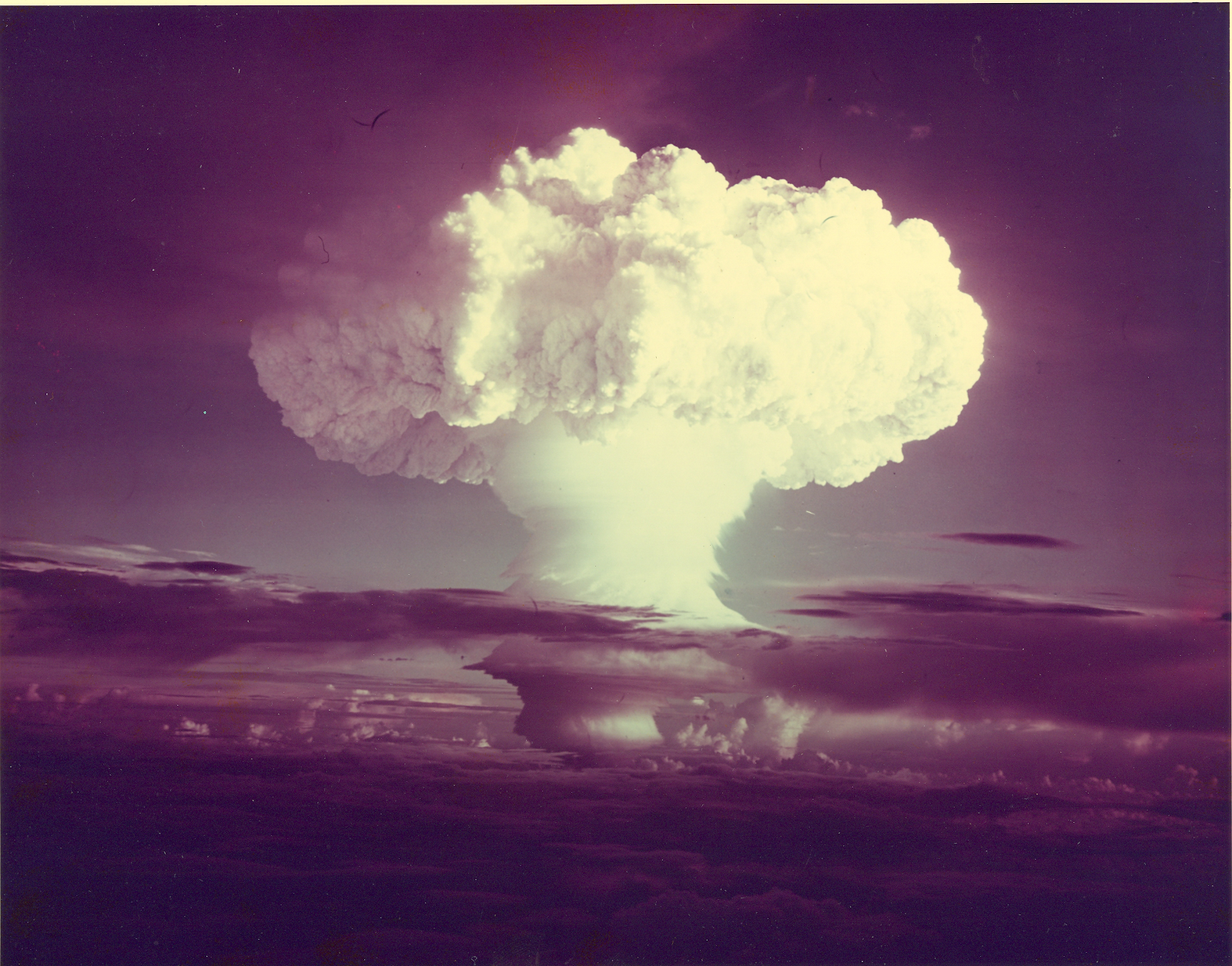
Alas, the creation of its thermonuclear weapons was only half the story. In 1949, the NATO bloc was created for military confrontation with the Soviet Union. Besides him, on the same continent with us there are many other countries that could be called US allies. Thus, by the early 1960s, we were surrounded by a whole network of air bases, where several hundred (!) Aircraft carrying atomic bombs were constantly on duty . For example, in 1961, at the disposal of the SAC - the United States Strategic Aviation Command - there were about 1,700 bombers, of which about 600 were strategic B-52s and about 1,000 B-47. And that's not counting the large number of light F-100s, which were supposed to take off from the Mark 28 air bases surrounding the USSR. From the sea, we were threatened by American nuclear-powered submarines Polaris. There were several dozen mine-based missiles.
And this whole armada was aimed at our cities. Daniel Ellsberg, a former employee of the RAND corporation with a very high level of tolerance, in his book “Doomsday Machine” claims that since the days of President Eisenhower (and even Truman), the Pentagon had a Unified Plan for the use of strategic forces and means - JSCP. He meant only one scenario of war with the USSR: a general thermonuclear war . You have no limited conflicts. There were no random shoot-outs "shot and hushed up", battles on the scale of a company or battalion. According to the JSCP, any use by the parties of weapons launched from the American side a procedure for the total destruction of the USSR with the obligatory execution of Appendix C, containing the SAC action plan for delivering nuclear attacks on all cities of the USSR with a population of 25 thousand people. Cancellation of a strike after giving an order, or delivering a limited strike, was not implied. Well, and if this is interesting to you, according to the same plan, China, which at that time was our ally, should have been automatically subjected to nuclear bombardment. Without exception.
As they say, all or nothing.
And this approach was explained extremely pragmatically: it was just that Eisenhower believed that the United States would not economically pull out a non-nuclear war with the USSR.
In 1961, the Joint Chiefs of Staff provided President Kennedy with an estimate of the enemy’s losses in the execution of the JSCP: in the USSR and China, 275 million people were to die in the first hours after the bombardment, another half million were due to radioactive fallout. As a result of strikes on targets in Eastern Europe — air defense positions and radars, in order to “pave corridors” for strategic bombers — another 100 million would have died in the first six months. Due to precipitation, in particular, after strikes on protected submarines in the region Leningrad and the Kola Peninsula, it was assumed complete extinction of Finland and partly Sweden. In total, in countries that are not members of NATO and the Warsaw bloc, 100 million more people were expected to lose. That is, the Americans estimated the total estimates of losses on the Eurasian continent as a result of mass nuclear bombardments to more than half a billion people . And no intermediate options were envisaged. Moreover, Americans estimated their own losses only in a few tens of millions of people, if a couple of our missile-carrying submarines broke through to them.
Theories of "nuclear winter" and " nuclear autumn " then did not exist. Like supercomputers capable of performing calculations of the transfer of radioactive precipitation between continents and the effects on the atmosphere of gigantic amounts of dust, smoke and soot from burning forests and cities.

Geography is relentless: unlike the United States, which many countries helpfully provide their territories for the deployment of ground forces, aircraft, missiles and radars, we do not have this luxury. To the borders of the United States of America, as Anatoly Wasserman likes to express himself, we can only approach from the sea or fly by air from another continent. And in the 1940s and 50s, it was much more difficult for us to do this because of the imperfection of technology. There were no satellites, the possibilities of radio reconnaissance are extremely limited - how can you tell if armada bombers are already flying to us? And so the idea of ultra-long-distance radar appeared.
Look beyond the horizon
Radio waves propagate in a straight line. And since the Earth is round, the beam, launched parallel to the surface, will go tangentially to the sky. However, our planet has an ionosphere - a highly ionized layer of the atmosphere, which starts from about a height of 60 km. The beauty of the ionosphere is that it is able to reflect short waves in the range of 3-30 MHz. This property formed the basis of over-the-horizon radar: the wave is emitted at a slight angle upwards, a small part of it ricochets away from the ionosphere, like a ball from a wall, “falls” to the surface and is reflected by the reverse path. Such an idea was first proposed in the world in 1947 by engineer Nikolai Ivanovich Kabanov, who proposed in this way to track high-flying aircraft, that is, strategic bombers.

If the signal is reflected from the ionosphere once, it is called single-radar, and sometimes it is multi-hop when the signal is reflected two or three times. One "jump" is equal to about 3000 km.
The main difficulty was that the signal reflected from the target was much weaker than the signal reflected from the surface of the planet. Moreover, the ionosphere is not monolithic and is not nailed to the sky: the height of its lower boundary fluctuates, as does the degree of ionization. Only by 1960, the scientific and industrial base allowed to create the first prototypes of over-the-horizon radar. With their help, it was possible to track not only the bombers, but also the launch of ballistic missiles, leaving behind an ionized trail. It was extremely important for us to learn about this as early as possible in order to have time to alert our own strategic forces and deliver a retaliatory strike.
Our civilization is still alive only because of the inevitability of atomic retribution.
In 1972, within the framework of the concept of an integrated missile attack warning system, it was decided to start building several radars of various types at once, including two stations of the Duga project 5H32 (the most monstrous), one near Chernobyl, the second near Komsomolsk-on-Amur. In the same year, the construction of the Chernobyl station began, and in 1976 it began work.
The “Russian Woodpecker” appeared on the air and began to hammer.
Arc
The radar station was built not far from the Chernobyl nuclear power plant: due to large losses during the passage of the signal over 3000 km and back, it was necessary to provide a huge pulse power, therefore the station was a VERY voracious consumer of energy. The receiving antenna complex, Chernobyl-2, consumed about 10 MW, and the transmitter consumption estimates, the Lyubech-1 in the Chernihiv region, vary greatly, from 8 MW to 160 MW per pulse.
Both Duga stations - in Ukraine and the Far East - blocked the entire territory of the United States across the North Pole (on the scheme in the direction of China, the experimental Duga-N near Nikolayev shines, confirming the effectiveness of the project, following launches at Baikonur). The viewing angle of each station was 50-75 degrees depending on the current state of the ionosphere on the signal path.
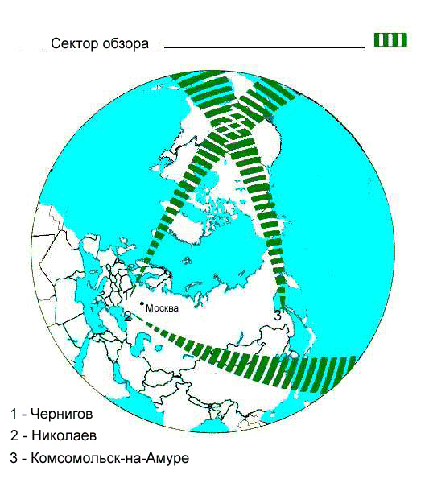
The Far Eastern Station has not survived to this day, nor has the Lyubech-1 antenna complex. Transmitting antennas were built on the phased array principle (PAR). They represented an openwork “wall” of steel structures 85 m high. But then the reception antenna complex “Chernobyl-2”, which they did not have time to cut into metal, survived to our days. The scope of the object is more than impressive.

The station operated at 3.26-17.54 MHz. The “wall” below (90 m high and about 250 m long) received a higher-frequency signal, the second (140 m high and about 450 m long) received a lower frequency signal.


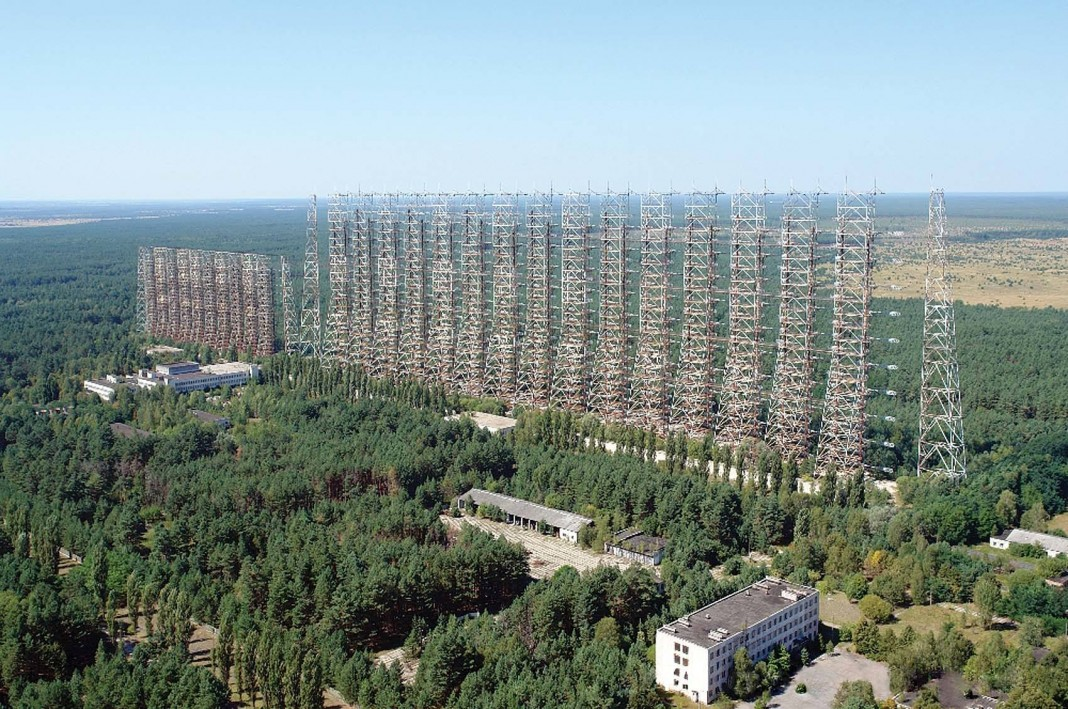
Receiving antennas are also giant phased arrays.
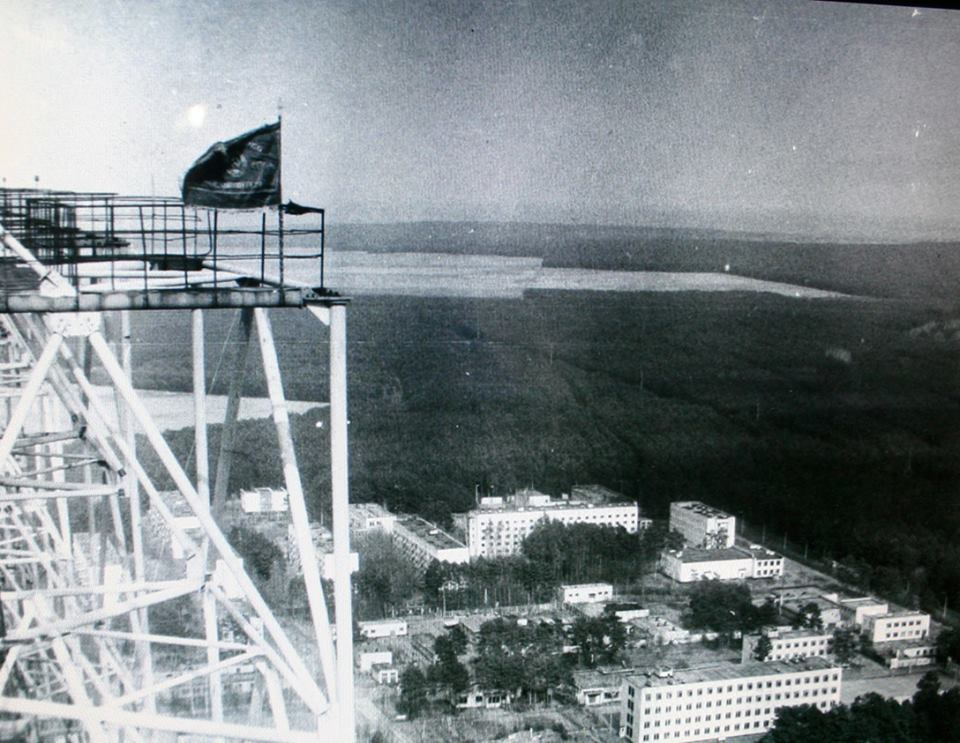


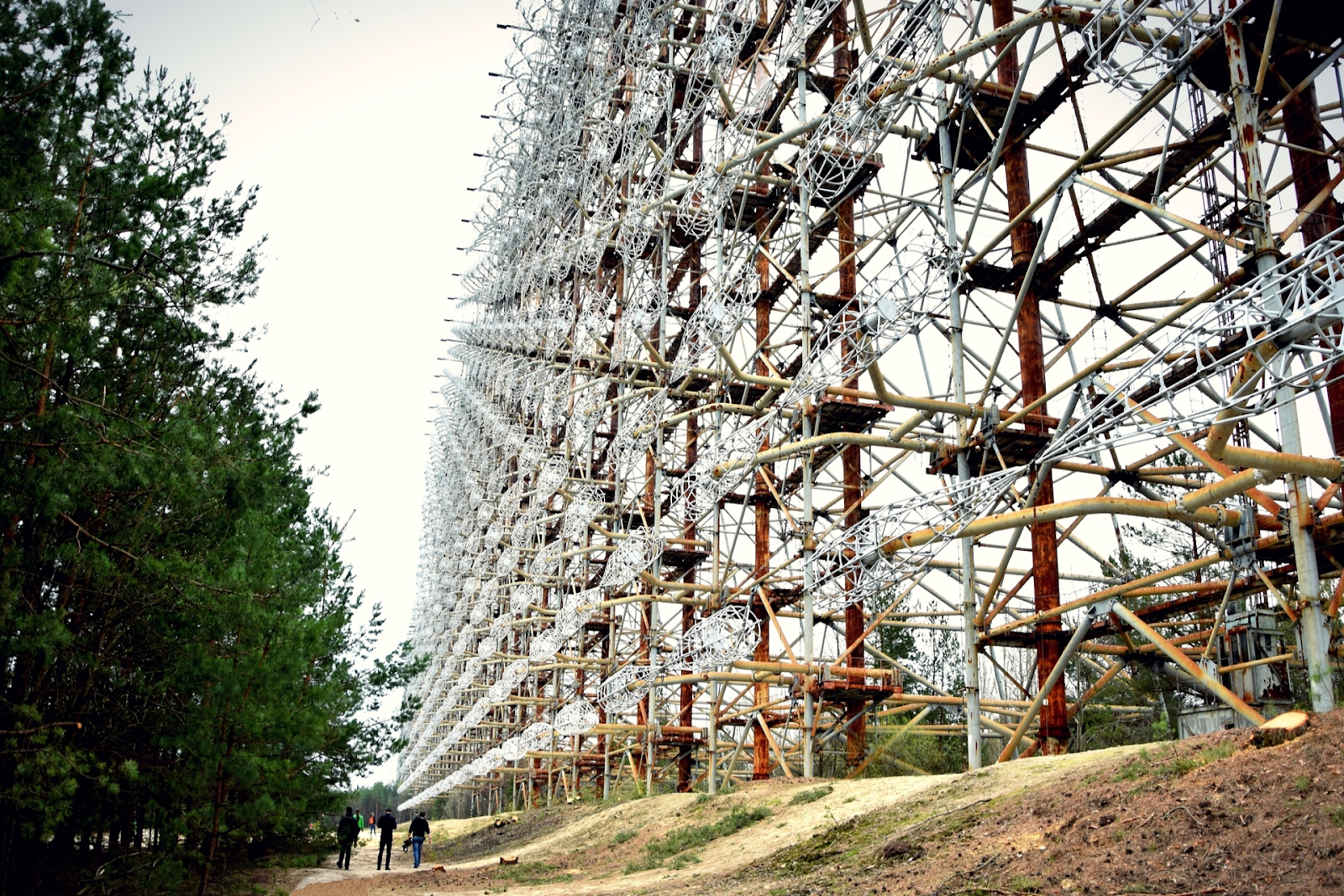

PHAR segment - emitter:



Saw, Shura, saw:
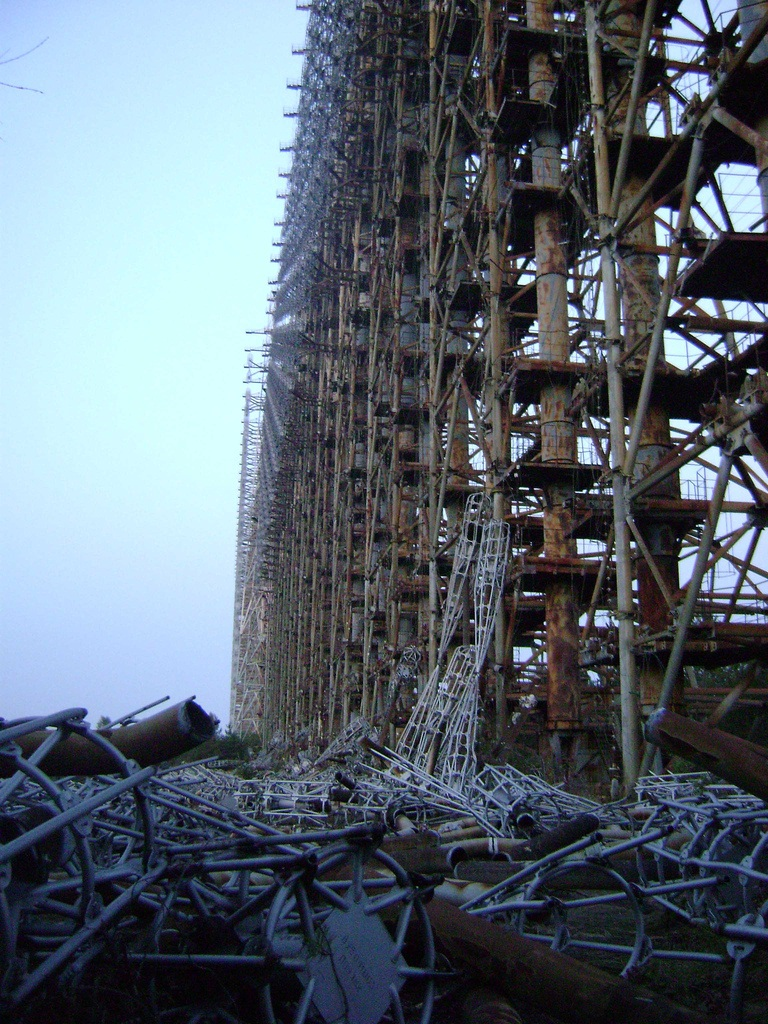
Also nearby was built an antenna complex VNZ "Circle" (station of reciprocating-inclined sensing), which was a 300-meter ring of 240 antennas with a height of 12 m.

It was an auxiliary object, intended for the permanent determination of the radio frequency, at which the waves at the moment when passing through the atmosphere were attenuated the least. This made it possible to adjust the current parameters of the main antennas of the “Arc” in order to receive only their own reflected signal. According to its purpose, the "Circle" was not used, it was occasionally carried out experiments.
Unfortunately, the development and construction of both stations did not take into account the treachery of the North: the ionosphere at high latitudes is very unstable, and the loss and distortion of the signal on the two-hop route turned out to be extremely high. As a result, none of the Doug could consistently detect individual planes and rockets, only mass launches.
After long trials of the military with developers and manufacturers, they began to look for ways to increase the efficiency of the stations when working through the pole of the planet. In 1983, the modernization of Chernobyl-2 began, which they were going to complete at the end of 1986. By the beginning of the year, the “Duga” near Chernobyl began to confidently detect the launches of “Shuttles” and intercontinental missiles at a distance of 7-9 thousand km. In particular, it was possible to register even the explosion of the Challenger in January 1986. However, they did not have time to complete the modernization - on April 26, the Chernobyl nuclear power plant exploded, which is only 9 km north of the radar station.

The station was stopped, the garrison and civilian personnel were evacuated. The following year, after several unsuccessful attempts at decontamination of the territory, the most valuable equipment was dismantled and removed to the second “Arc”. But despite the good results in detecting aircraft at a distance of 3,000 km, the Ministry of Defense has already lost interest in ultra-long-distance radar - satellite systems were considered a more promising means. In 1989, the Far Eastern station was removed from combat duty, and in the late 1990s sawed into scrap metal.
So ended the story of the world's first ultra-long over-the-horizon radar. Today it is considered that the cause of the failure of the project was a very bold idea, which was difficult to implement on the technologies of those years. Perhaps, by the beginning of the 1990s, the “Dugu” would have been able to bring to mind, all the more so as the work on modernization was very hard. The total cost of the program amounted to about 600 million rubles, of which about 150 million was spent on the construction of "Chernobyl-2". For comparison, in the mid-1980s, the cost of one nuclear submarine of the project 949A (according to which the Kursk was built) was 226 million rubles.
Source: https://habr.com/ru/post/351212/
All Articles